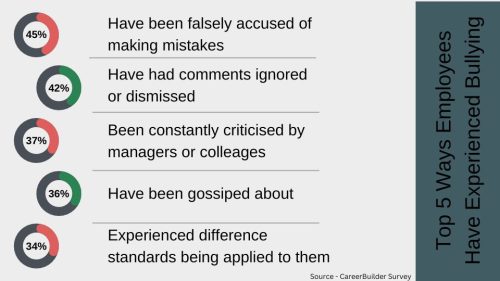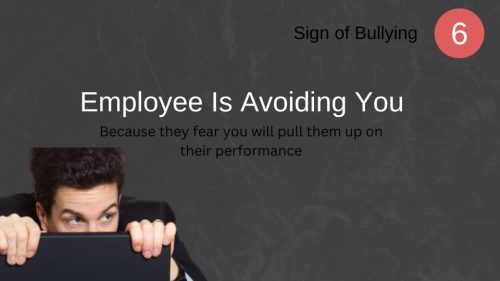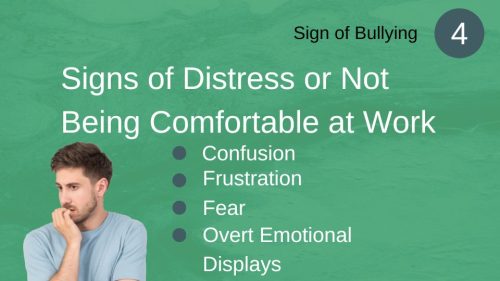How to Spot Bullying on Your Team

Knowing how to spot bullying on your team as a manager is super useful. Bullying is very damaging to team motivation and performance. Bullying is very tough for those on the receiving end of being bullying behaviour. Not doing anything about bullying – through ignorance, not knowing what to do or being unwilling to act – is very damaging to your reputation and standing as a manager. Per a CareerBuilder survey 30% of office worker have been bullied so bullying remains a very real problem.
Putting yourself in a position to spot bullying on your team is not as easy as we hope it is.
How to Spot Bullying on Your Team
- Why the impacts of bullying matter to you
- 6 Signs of employees being bullied
- 5 types of not-so-subtle bullying
- 12 types of subtle or covert bullying
Covert bully or subtle bullying is more common that overt bullying in the workplace because:
- Covert bullying is easier to hide and harder to spot
- Covert bullying is much harder to prove by managers or HR
- The bullies are more likely to get away with it
At the end of the video, after identifying workplace bullying, I have some tips on how to tackle bullying at work.
Watch on YouTube
Listen on Podcast
Bullying is repeated behaviour that is meant to hurt and control another person. We all make mistakes and say or do dumb or insensitive things at times. Bullies repeat behaviour they know hurts or controls others again and again over time. That is quite different from making one-off mistakes.
So let’s talk about:
Why the impacts of bullying at work matter to you
Bullying in the workplace increases the risk of negative mental and physical health issues for both the victims of bullying as well as their co-workers.
Team members that are being bullied at work don’t perform at their best. They may have periods unable to concentrate on their work, they suffer from loss of self-esteem and confidence, they have more trouble making decisions and they will have lower productivity. Bad for them and bad for you as manager of the team they are in.
Bullied employees lose time as well as motivation.
They will spend time avoiding the bully or situations which might lead to bullying. They spend time trying to mentally deal with the situation they find themselves in. They spend time networking to gain support and spend time trying to defend themselves against bullying in the workplace. The loss of energy and focus on doing a good job can be significant.
In addition to the impact on the person being bullied, colleagues who witness bullying are also impacted with lower motivation and fear that the working environment is hostile. Teams experiencing bullying within them suffer greater absenteeism and reduced productivity. Staff turnover is likely to be higher, leading to greater costs to recruit and train staff. And finally, you have the impact of potentially costly and embarrassing legal action for the business. Use these 7 methods to motivate a team to counter act these effects
None of these impacts from bullying is going to help you, the team, or the business. Bullying is a very costly set of behaviours to ignore for everyone concerned. As a result managers should constantly keep an eye out for bullying behaviour and stop it as quickly as possible.
When thinking about how to spot bullying as a manager look out for these
6 Signs of employees being bullied
The individuals being bullied often – but not always – display a change in behaviour. If your team members show any of these signs of a bully at work start investigating their change in behaviour:
- Looking increasingly anxious, agitate or withdrawn
- Complaining about not sleeping or start suffering headaches or stomach problems,
- Have increased absence from work through sick days
- Signs of distress at work or not being comfortable in the office – such as confusion, frustration, fear, and uncharacteristic overt emotional displays
- A previously good employee has a noticeable drop in performance
- the employee is avoiding you – their manager – because they fear
How to spot bullying on your team is not easy as these changes may happen quite gradually over weeks or longer. Be persistent and empathetic when asking questions. Bullying is only one possible reason that the individual is displaying these behaviours.
Keep a much closer eye on any individual displaying any of these signs and pay particularly attention to how they are interacting with each of the other members of your team. Pay attention to their body language and behaviour.
Keep asking questions of the person and other team members until you understand what is happening and the events and actions you are seeing align with what you are being told.
Don’t stop asking questions or trying to find out until these signs disappear or you know bullying or other issues are taking place.

When considering how to spot bullying on your team, here are
5 signs of overt bullying to watch out for:
Physical intimidation
Which I think is rare in professional workplaces in my experience. If physical intimidation did occur and anyone witnessed it, the bully should find themselves in a disciplinary process fairly quickly. Physical bullying can also include damage to your property or the bully going through your desk or bag for instance.
Aggressive behaviour
Toward the team member being bullied – such as shouting, aggressive or angry tones of voice and aggressive use of body language to intimidate without physically threatening others.
Using unreasonable public criticism
To put the person being bullied down, undermine their confidence and hurt them. This could include falsely accusing a person of mistakes or attributing blame incorrectly to the person being bullied.
Using offensive language
To shock, upset or intimidate the target of bullying.
Humiliating the person being bullied
Socially or professionally. This could be through excessive teasing, criticism, always bringing up mistake made, sharing any embarrassing incidents in or out of work and any other actions to publicly put the person being bullied down

Most bullying in the workplace is more subtle or covert in nature. The group most likely to engage in more overt bullying are managers. It is unfortunately easier for managers to bully overtly and get away with it because of their increased influence within a business.
Keep an eye out for other managers using bullying tactics on your team members and take action to protect them and bring the bullying behaviour to light.
Identifying workplace bullying is usually a lot harder because bullies tend to use tactics that are a lot harder to spot and prove are taking place.
When considering how to spot bullying on your team, here are
12 signs of more subtle or covert bullying behaviours to watch out for:
Ignoring
– forgetting to invite the team member they are bullying to meetings, or not including them in emails, not talking to them and all the other ways to cut a person out of team lifeIsolating or excluding
the staff member they are bullying. Usually making them feel physically or socially excluded from the group. This could be moving them to a desk away from the group, trying to influence other team members to spend less time with the person being bullied, or not inviting them to social events.Taking credit for ideas or work
undertaken by the person being bullied. This tactic improves the bully’s own standing while putting down the person they are targeting. This tactic creates a lot of frustration and resentment.Setting impossible targets or deadlines
– which the victim will not be able to deliver against and then using the failure to put down the individual. This can crush the confidence and resistance of the person being bullied.Withholding important information
or giving wrong or incorrect information to they person they are bullying so that the work they do is impacted, the number of mistakes increased, and the bully has more ammunition for criticising and other actions.Spreading negative rumours or gossip
about the person they are bullying to reduce confidence, influence the groups view of the person, make their target look bad – all actions to put down an individual and reduce the target’s influence within the group.
Undermining either the work and or the reputation
of the person being bullied. Examples include being overly critical, highlighting any mistakes while ignoring the good parts, downplaying the works importance, providing unfair and unbalanced feedback to peers and more senior management – are all ways of undermining the person being bullied.
Denying training, promotion, or good development opportunities
to the team member they are bullying. These actions slow or stop the career progress of the person being bullied and help assert control over the person being bullied.
Constantly changing expectations
or being purposely inconsistent in actions and decisions relating to the person being bullied. These actions make it very hard for the person being bullied to deliver to expectations and look good to manager and peers.
Favouritism
– treating most people in one way and then treating the person they are bullying in a different more negative way. This behaviour also reinforces the sense of isolation that many people being bullied feel.
Removing work or duties or responsibility
from the person they are bullying. This reduces the value that person is able to add to the business and reduces their sense of satisfaction and self-worth.
Micromanagement
can be used as a bullying tactic when the individual is doing their tasks perfectly well and imposing a micromanagement style takes away the individual’s responsibility and autonomy and exerts control by the bully over the individual.

Subtle or covert bullying is much more common as it is harder to detect and take action against. I personally have experienced attempts to bully by both colleagues and managers during my career.
As you may have guessed, managers are able to undertake many of the covert actions of bullying much more easily than colleagues. Keep a close eye on the managers in your team. Does their team look and act happy and motivated? Do they seem fearful and hesitant? How does the manager speak about their team? Keep a closer eye those in your team in positions of responsibility and power.
Here are the top 5 ways employees have experienced bullying per a CareerBuilder survey:
45% have been falsely accused of making mistakes
42% have had comments ignored, dismissed, or not acknowledged
37% have been constantly criticised by managers or colleagues
36% have been gossiped about
34% experienced different standards or policies being applied to them
Look out for our video on how to tackle bullying behaviour as a manager when you spot bullying behaviour or are told of bullying behaviour taking place. We will also include what you can do if your manager is the bully.

In summary
It is very important as a manager to take action quickly when you spot signs of a bully at work or investigate if you are told that bullying might be taking place.
Bullying is one of the worst examples of poor and unacceptable behaviour in the workplace and is very destructive to team motivation and performance. As a manager if you don’t take action when you should have, you will lose the trust of many of the team members and your manager when your lack of action comes to light. Work out how to spot bullying in the workplace and then take action when you suspect bullying is happening. You are in the best place to do both.
There is a lot you can do as a manager to take action against a bully and communicate to everyone that bullying behaviour in all its forms is not acceptable. Escalating steps to take include:
- Start by having an informal conversation to tell the bully to stop
- Put them on an informal Performance Improvement Plan
- Put them on a formal Performance Improvement Plan
- Start a disciplinary process with the bully
Where you start on this scale depends on the situation – how severe the bullying has been, how long it has been going on for and the impacts of the bullying.
The quicker you can spot bullying on your team and take action, the less damage will be done to the individuals concerned, the team motivation, to your reputation and to the business overall.
Make the time to identify workplace bullying and quickly investigate the cause of any signs of a bully at work.

Bullying on your team is a major issue that nearly all managers want to stop quickly. Spotting bullying behaviour, as I have found out personally, is quite hard in practice. Many employees are good at managing upwards and ensuring the negatives messages don’t often get to their manager.
Make the time to watch the behaviours and non-verbal clues when team members are interacting and listen for comments made by team members about situations in the team. Ask questions and be inquisitive. If you are looking, it will be that much harder for a bully to hide their actions.
Investigate any signs that individuals are being bullied or are using bullying tactics within your team or with those outside your team.








